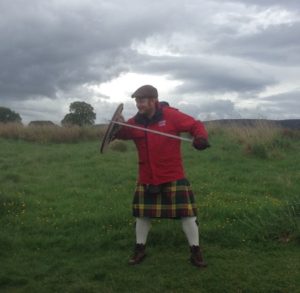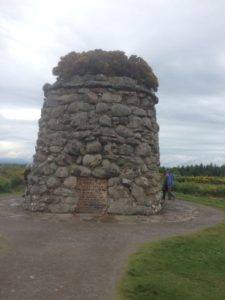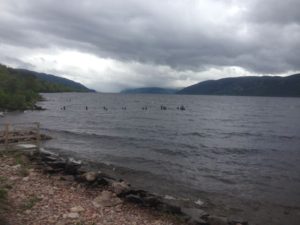We landed in the port of Cromarty Firth (firth is Old Norse for fijord) beside the town of Invergorden. We had booked a tour through Wow Scotland, and red-headed, blue-eyed Gordon met us as we walked out of the port. We had a choice of sandwiches for a bag lunch we would pick up at Culloden This tour includes Brodie Castle, Clava Cairns, Culloden Battlefield, Loch Ness and Inverness.
As we drove along the shores of the Cromarty Firth we saw several parked well drilling platforms, sometimes abandoned for many years, but we also spotted seals and oyster catchers.
The land is as green as Ireland but with no stone fences separating fields. Clearly, this is better farmland, with huge fields of green barley (primary ingredient in Scotch). The hills and roads were in full bloom with gorse (dying out) and broom, another even brighter yellow head-high plant).
 At Brodie Castle we are treated to a private tour before the castle opened. Built in 1567, it is a Z plan defensive castle with defensive measures such as entering the main hall through a window through a removable ladder or stairs, turrets with musket slots, and narrow spiral staircases. The house has been lived in sine the 1500’s and was donated to the national trust with the provision that it be preserved as it is.
At Brodie Castle we are treated to a private tour before the castle opened. Built in 1567, it is a Z plan defensive castle with defensive measures such as entering the main hall through a window through a removable ladder or stairs, turrets with musket slots, and narrow spiral staircases. The house has been lived in sine the 1500’s and was donated to the national trust with the provision that it be preserved as it is.
 Clava Cairns is a group of prehistoric burial cairns which were built around 4000 years ago. This Bronze Age cemetery has passage graves, ring cairns, and standing stones, all centered around summer and winter solstices. The Victorians planted trees to make the site more atmospheric so today site does get the light it would have 4000 years ago.
Clava Cairns is a group of prehistoric burial cairns which were built around 4000 years ago. This Bronze Age cemetery has passage graves, ring cairns, and standing stones, all centered around summer and winter solstices. The Victorians planted trees to make the site more atmospheric so today site does get the light it would have 4000 years ago.
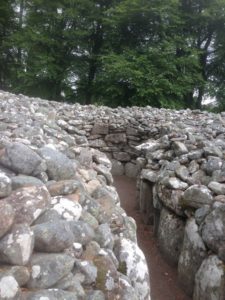
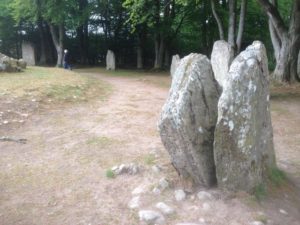 White quartz standing stones would have caught rays of sunrise and red sandstone stones would have caught sunset light. The Outlander series begins with the heroine falling back in time through a split stone such as the one found here. The samhain stone used to mark the 45 days before and 45 days after the winter equinox is also featured in her book.
White quartz standing stones would have caught rays of sunrise and red sandstone stones would have caught sunset light. The Outlander series begins with the heroine falling back in time through a split stone such as the one found here. The samhain stone used to mark the 45 days before and 45 days after the winter equinox is also featured in her book.
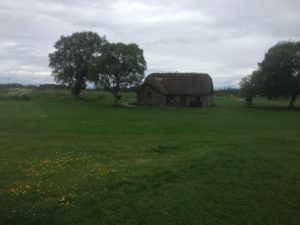 The Battle of Culloden (4/16, 1746) was the last battle fought on British soil. It pitted 8000 Highland Clansmen attempting to reclaim the throne of the exiled Stuart heir, Bonnie Prince Charlie (Jacobites) against the British Hanovarian soldiers. The Jacobites had great success earlier, almost reaching London before they chose to retreat to the highlands. The should never have fought in a broad open plane such as Culloden because that favored English tactics. The highlanders fought by charging the enemy line and using sword and dirk (dagger) to kill the enemy.
The Battle of Culloden (4/16, 1746) was the last battle fought on British soil. It pitted 8000 Highland Clansmen attempting to reclaim the throne of the exiled Stuart heir, Bonnie Prince Charlie (Jacobites) against the British Hanovarian soldiers. The Jacobites had great success earlier, almost reaching London before they chose to retreat to the highlands. The should never have fought in a broad open plane such as Culloden because that favored English tactics. The highlanders fought by charging the enemy line and using sword and dirk (dagger) to kill the enemy.
Unfortunately they were mowed down by British rifles as they charged and then the British line closed around them and 1,500 men were killed in an hour, compared to 50 British deaths.
The battle marked the end of the clan system, and assertion of English control. Many castles were burned and the lands given to the English. In the Highland Clearances, farmers were kicked off their land, sometimes burned out, in order to make way for sheep. This inaugurated the mass emigrations to Canada and the United States.
Our tour then headed for hills for beautiful Highland scenery. We traveled up a narrow road into the mountain moorlands with both sides of the road blooming in yellow. We had a good view of the rift valley. Northern Scotland has been slidding slowly southwest (rocks on both sides are 65 ft distant).
We took the very narrow Trail of Lochs above Lock Ness with both sides of the road filled with blooming gorse and broom.
When we started to turn down to Lock Ness, the road was closed and we were forced to retrace our steps and take an even tinier side road down the mountain. We couldn’t believe that they would attempt this road in a full-sized coach (apparently they had never tried it before). If we had met anyone on the road, someone would have had to back a very long way.
We arrived at the village of Dores on Lock Ness to a strong cold wind, a good excuse for a whiskey (if the drive hadn’t been).
We drove through the villages of Evanton and Alness on the way back to the port of Invergordon.




